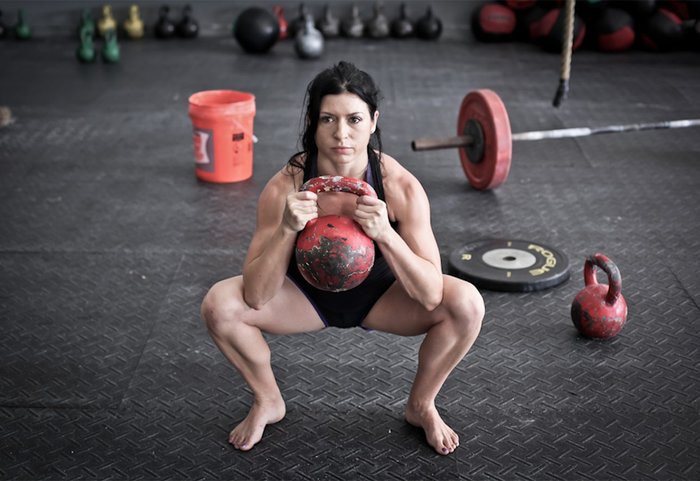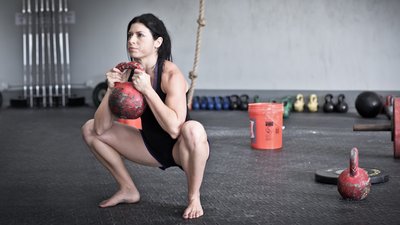Why challenge yourself with goblet squats? Why not, say, hit heavy back squats every day? Because while there's a time and a place to go heavy, there are also great benefits to be gained from racking up lots of volume with picture-perfect form. And as plenty of personal trainers can tell you, the goblet squat is the best-looking, easiest-to-teach squat variation around.
With this in mind, I recently conducted an online 21-day squat challenge. Hundreds of men and women joined in, with an overwhelmingly successful outcome. In just 21 days, they experienced personal records with their squat strength, increased energy, firmer glutes, alleviated knee and back pain, and some surprising weight loss.
Why the three-week timeframe? In 21 days, with enough repetition, your body can learn a skill and become remarkably strong at it. But this challenge is also designed so you won't burn out or overdo it. It's designed so you can reap the benefits of proper squat practice.
Stick with this squat plan, and I guarantee you won't regret it. If you had any idea of the epic results you'd get from adding lots of squats to your life, you wouldn't think twice about starting today!
The Case For Squats
Squats aren't called the "King of Exercises" for no reason. In fact, you naturally gravitated to a perfect, deep squat when you were a toddler. I remember both of my little ones playing with their toys or holding their bottle for minutes on end while sitting in the squat position. It's about as natural a human position as it gets.
However, many of us stop squatting as we grow older, especially in Western society. Many other cultures, like those in Asia, still eat, work, and give birth in the deep-squat position.

So what's the big loss? Believe it or not, not squatting can actually increase your mortality rate, according to Brazilian physician Claudio Gil Araújo. Araújo conducted a study around the idea of being able to get up and down off the floor. According to his research, people who weren't successful at being able to get up and down off the floor from the seated position, without using their arms—in other words, from an easy squat—had a three-year shorter life expectancy compared to those who were successful.[1]
But aside from their association with longevity, squats offer plenty of life-enhancing—and body-enhancing—qualities as well. Properly executed squats make you stronger, increase your conditioning, firm your legs and gluteal muscles, and strengthen your hips and knees. You'll also gain mobility in your hips, knees, and ankles. Plenty of people even report that their digestion is better once they get their squat back!
Squats are truly one of the most beneficial exercises to practice. If you have to choose just one exercise to focus on, squats should be it.
Your Guide To Goblets
Here's how to perform a perfect kettlebell goblet squat, the move you'll be using for the next three weeks:
- To get the kettlebell into position, start with a two-handed kettlebell swing and "catch" it at the top, so that you're holding the kettlebell by the horns.
- Take a breath, and slowly lower yourself down, using your elbows to push your knees out and open your hips. Only go as low as feels comfortable, and focus on improving your depth over time.
- Pause for a second. Pressurize your abdomen, and straighten out, pushing steadily through your heels as you ascend back to the top position.
If you have really tight calves or ankles, feel free to put a small plate under your heels. If you're strong on goblet squats, you can use double-kettlebell front squats instead.
Now let's get squatting!
The Squat-Challenge Details
Directions: Each week, pick a weight, and stick with that same weight every day that week. Add more weight in subsequent weeks. Beginners should start with no weight.
Wondering how much to weight to choose? Start conservatively on Week 1. By Day 7, you should have a pretty good idea how much more you can handle! One advantage of using kettlebells is that they come in 4-kilogram or 8-kilogram "jumps" that are perfect for many of people.
Example 1: Beginner
- Week 1: Bodyweight
- Week 2: 18 lbs. (8 kg)
- Week 3: 26 lbs. (12 kg)
Example 2: Advanced
- Week 1: 53 lbs. (24 kg)
- Week 2: 70 lbs. (32 kg)
- Week 3: 88 lbs. (40 kg)
You'll figure out the right weight for yourself quickly enough. Your real job is to do the reps! Break them up into as many sets as you want. For example, if you are supposed to do 20 reps, you can do 4 sets of 5 reps or 2 sets of 10 reps. Just get them done!
21-Day Squat Challenge
Week 1: Bodyweight Or Starting Weight
- Day 1: 20 reps
- Day 2: 25 reps
- Day 3: 30 reps
- Day 4: 35 reps
- Day 5: 40 reps
- Day 6: 45 reps
- Day 7: 50 reps
Week 2: Add Weight
- Day 8: 20 reps
- Day 9: 25 reps
- Day 10: 30 reps
- Day 11: 35 reps
- Day 12: 40 reps
- Day 13: 45 reps
- Day 14: 50 reps
Week 3: Add Weight Again
- Day 15: 20 reps
- Day 16: 25 reps
- Day 17: 30 reps
- Day 18: 35 reps
- Day 19: 40 reps
- Day 20: 45 reps
- Day 21: 50 reps
My Results With The Squat Challenge
I started the squat challenge with a 44-pound kettlebell. It felt challenging on the first day. The last day of the challenge—that's just three weeks later—I tested myself with a 97-pound kettlebell. Here's what happened:
The toughest part for most people, honestly, is getting that heavy bell into position by the end. One swing might not be enough for a small person to get something well over half their body weight up to chest level. If that's the case, add another swing!
What Do People Say About The Challenge
Pete is a 64-year-old who works a manual-labor job, so being fit is vital to his ability to earn money and stay injury-free on the job. Here's what he had to say about his 21-day squat-challenge experience:
"[The squat challenge] was probably the singl- best experience I've ever had in my fitness life. I have always been a fitness 'loner'—no gym, no workout buddies. I've simply gone out to my shed or worked out in my computer room. But I have to stay fit because I'm a full-time, second-shift, blue-collar worker in a manual-labor-intensive job with no retirement in the cards. But I had been flagging, and my workouts were infrequent and stale.
"But something about Lauren's challenge called to me, and once I started it, I was hooked! It's not the weight, or the number of sets it takes to do the reps—it's you, in there, slugging away consistently."
Another participant, Gemina in Hawaii, said, "This challenge was awesome, with no dread factor at all. Even on days I didn't feel great, I was able to accomplish the challenge training, and it always re-energized me. This was a great add-on to other training sessions, or even great on rest days."
So what are you waiting for? Start your squat challenge today! We had quite a few moms doing squats with kids on their backs toward the end. I even enjoyed it with my 9 year old on my back.
Let me know if you have any questions about the squat challenge. Happy squatting!
References
- de Brito, L. B. B., Ricardo, D. R., de Araújo, D. S. M. S., Ramos, P. S., Myers, J., & de Araújo, C. G. S. (2012). Ability to sit and rise from the floor as a predictor of all-cause mortality. European Journal of Preventive Cardiology, 2047487312471759.

